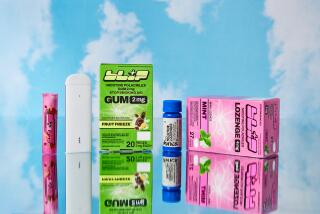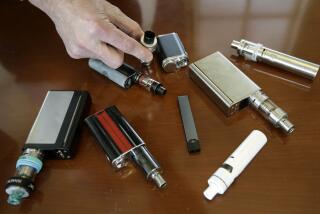Juul wanted to revolutionize vaping. It took a page from Big Tobacco’s chemical formulas
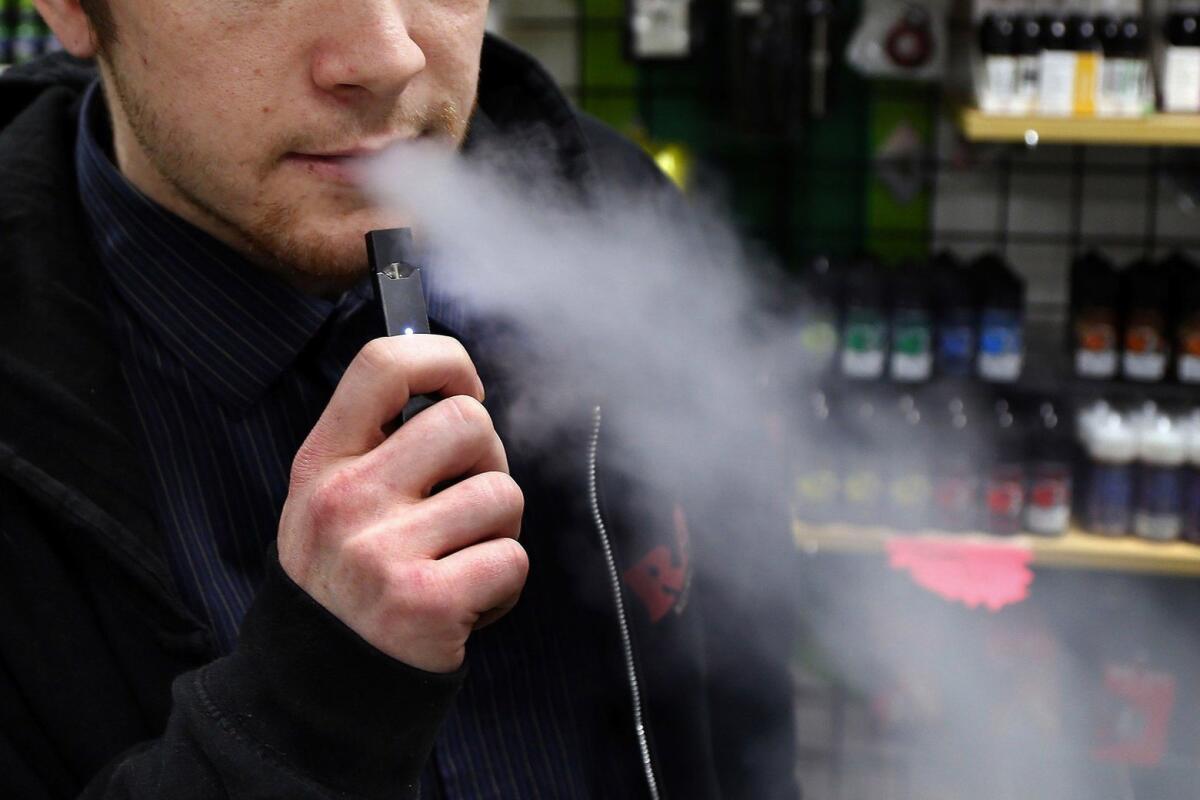
- Share via
By the time Juul’s co-creator stood before a tech audience in April 2016, ads for the e-cigarette aimed to distance the product from a toxic past: “Our company has its roots in Silicon Valley, not in fields of tobacco.”
But when James Monsees, a soon-to-be billionaire, projected a 30-year-old tobacco document on the screen behind him, he grinned. It was an internal memo from the research troves of R.J. Reynolds, the maker of Camel cigarettes. It was stamped “SECRET.”
“We also had another leg up,” Monsees said.
A review by the Los Angeles Times of more than 3,000 pages of internal Juul records, obtained by the Food and Drug Administration and released to a researcher through the Freedom of Information Act, found that the concept behind the formula that makes Juul so palatable and addictive dates back more than four decades — to Reynolds’ laboratories.
The key ingredient: nicotine salts.
Juul’s salts contain up to three times the amount of nicotine found in previous e-cigarettes. They use softening chemicals to allow people to take deeper drags without vomiting or burning their throats. And they were developed based on research conducted by the tobacco companies Juul claimed to be leaving behind.
In addition to the internal documents, The Times consulted more than a dozen tobacco researchers, policy experts and historians, and reviewed patent applications and publicly available videos of Juul’s founders discussing their product over the course of a decade. One of those videos has since been removed from YouTube.
Taken together, the evidence depicts a Silicon Valley start-up that purported to “deconstruct” Big Tobacco even as it emulated it, harvesting the industry’s technical savvy to launch a 21st century nicotine arms race.
In multiple conversations with The Times, Juul did not directly address assertions that the company embraced the very industry it sought to dismantle. A spokesperson for Juul acknowledged that the product intentionally “mimicked” the nicotine experience of a traditional cigarette, but explained that the formula was designed that way in order to satisfy the cravings of adult smokers, not children.
“We never designed our product to appeal to youth and do not want any non-nicotine users to try our products,” a spokesperson for Juul said in a statement to The Times. “We are working to urgently address underage use of vapor products, including Juul products, and earn the trust of regulators, policymakers, and other stakeholders.”
After extensive lobbying by the vaping industry and its allies, President Trump this month missed the deadline he set to ban vaping flavors, despite mounting public complaints over their attractiveness to teenagers, and it’s now unclear whether the administration will take any action. On Monday, California Atty. Gen. Xavier Becerra and Los Angeles officials announced a lawsuit against Juul, alleging it engaged in deceptive practices with kid-friendly advertising and a failure to issue health warnings.
But a new generation of nicotine addicts has already been established, and health experts warn that millions of teenagers who currently vape could ultimately turn to other products like cigarettes for their fix.
“Reynolds successfully engineered this formula, but it was Juul that ultimately vaporized it — and achieved what Big Tobacco never could,” said Robert Jackler, a Stanford University researcher focused on teenage e-cigarette use. “They studied Reynolds literature, took advantage of it, and addicted a new generation of American youth.”
Making nicotine more palatable
In February 1973, a researcher at Reynolds saw a conundrum: While cigarettes had wide appeal to adults, they would never become “the ‘in’ products” among youths.
For a teenager, the physical effects of smoking were “actually quite unpleasant,” Claude E. Teague Jr., who is now deceased, wrote in a confidential internal memo.
“Realistically, if our company is to survive and prosper, over the long term, we must get our share of the youth market,” he wrote. “There is certainly nothing immoral or unethical about our company attempting to attract those smokers.”
Reynolds had known for two decades that its product caused cancer. Still, one of the company’s top researchers, Frank G. Colby, pitched a design late in 1973 that would secure “a larger segment of the youth market” by packing “more ‘enjoyment’ or ‘kicks’ (nicotine)” and softening the chemical’s harsh effect on the throats of young smokers.
By boosting nicotine, the addictive chemical, the company could generate faster and more intense addictions among the youngest clients, securing decades of business. But a key challenge was to make nicotine palatable: The chemical had been used as an insecticide since colonial times, and three drops on the tongue could be lethal, according to Robert Proctor, a cigarette historian at Stanford. People couldn’t inhale hefty doses without vomiting.
Reynolds scientists eventually found a solution: Combine the high-pH nicotine with a low-pH acid. The result was a neutralized compound called a salt — nicotine salt.
To perfect the technique, the company enlisted one of its chemists, Thomas Perfetti, a 25-year-old with a newly minted PhD.
Perfetti got to work on a six-month investigation into nicotine salts. According to his laboratory notes, he stirred round-bottom flasks of various acids, then added nicotine, watching as the ingredients condensed into thick yellow oils. All were odorless except one, he wrote, which smelled like “green apples.”
Perfetti synthesized 30 different nicotine salt concoctions, then heated them — like a smoker would — in pursuit of the “maximum release of nicotine.” He also tested the salts’ ability to dissolve into a liquid — a trait that would decades later become central to vaping products like Juul.
On Jan. 18, 1979, Perfetti scribbled his signature on a 17-page final report. The results were stamped “CONFIDENTIAL.” He was soon promoted.
Ten years later, Reynolds was granted a patent for its salts, with Perfetti’s name listed among three inventors. Perfetti would go on to receive a Lifetime Achievement Award from the Tobacco Science Research Conference.
Perfetti, who has since retired from the company, confirmed the details of his research to The Times in a LinkedIn message, but declined to comment further.
Kaelan Hollon, a spokesperson for Reynolds, told The Times that the nicotine salts research was conducted as the company aimed to “reduce the risks” of smoking while “maintaining nicotine delivery.” Although the salts were patented, they were ultimately never used in a traditional Reynolds cigarette, she added.
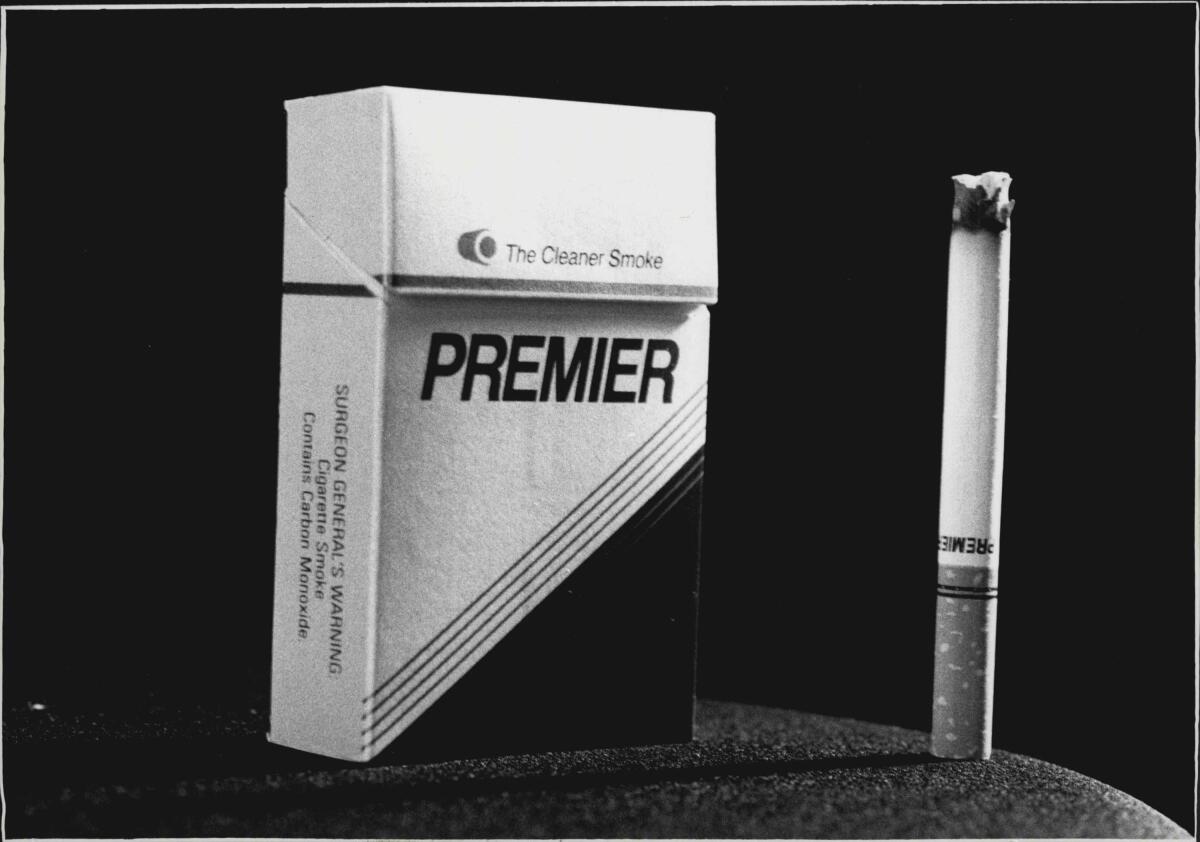
About the same time, in 1988, Reynolds introduced one of the first-ever aerosol cigarettes: Premier. After five months, it was pulled from the market because of low sales, records show.
“It made me nauseous for the rest of the day,” one tobacco distributor told The Times in 1989, saying he was sending back thousands of dollars’ worth of the aerosol cigarettes to Reynolds.
At the time, the company was facing another obstacle to using its new research: the FDA’s mounting outrage over what health experts called its “deceptive” past. In 1998, Reynolds, along with three other companies, agreed to begin paying billions of dollars to compensate states for having knowingly propelled a smoking epidemic, which by then had led to the deaths of about 20 million Americans. According to Proctor, Reynolds’ Camel cigarettes have killed about 4 million.
Within this climate, the company was unable to combine its two technical triumphs — palatable salts and early vaping equipment.
“Reynolds succeeded in developing the technology, but never really succeeded in turning it into a transformative breakthrough,” said Matthew Myers, the president of the Campaign for Tobacco-Free Kids in Washington, D.C.
“Juul did that.”
‘Addiction is central to the business model’
In June 2005, two product design students at Stanford moseyed in front of a classroom to present their graduate thesis, titled “The Rational Future of Smoking.” It was, in a way, the birth of an industry.
As the lights dimmed, the students, Adam Bowen and Monsees, projected an image onto a screen of a man puffing an early prototype of a vape pen — a precursor to Juul.
A video of the event shows the two students pitching their audience for 17 minutes on a device called Ploom, a vaporizer that would provide “a lot more effective way of releasing nicotine.” They illustrated the stigma of traditional cigarettes — using a South Park cartoon clip that called a smoker “Dirty Lung” and “Tar Breath.” They likened their nicotine pods to sleek Nespresso cartridges that were “a big hit in Europe.”
“We can take tobacco back to being a luxury good — and not so much a sort of drug-delivery device,” said Bowen, who went on to become Juul’s co-founder and chief technology officer.
Monsees said the pair had scrutinized the research behind Reynolds’ failed Premier model before designing their own. He projected a snapshot of chemistry charts from the company’s internal records.
“They’ve realized that they’re killing off their own client base, so they sunk several billion dollars into this already,” Monsees said.
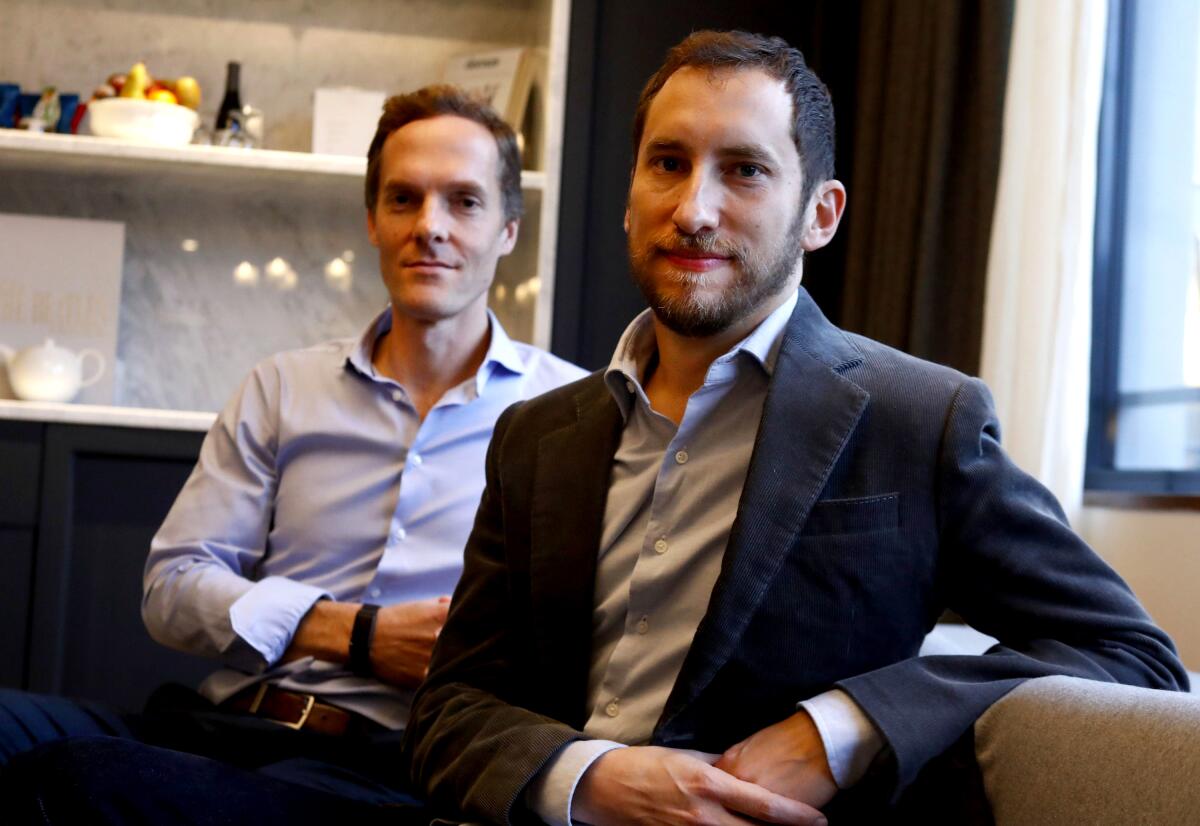
When Bowen clicked to the final slide, a video began to play: A man peering into a video camera lens gave a testimonial, gripping the vaporizer prototype in his hand.
“This product is the greatest thing I have ever encountered in my life,” he said. “I will smoke this with enthusiasm, and develop a nicotine habit that will follow me to my grave.”
The class howled with laughter and broke into applause, launching Monsees and Bowen into a decade of product development. The Ploom device entered the market and would evolve into Pax, and in 2015, Juul.
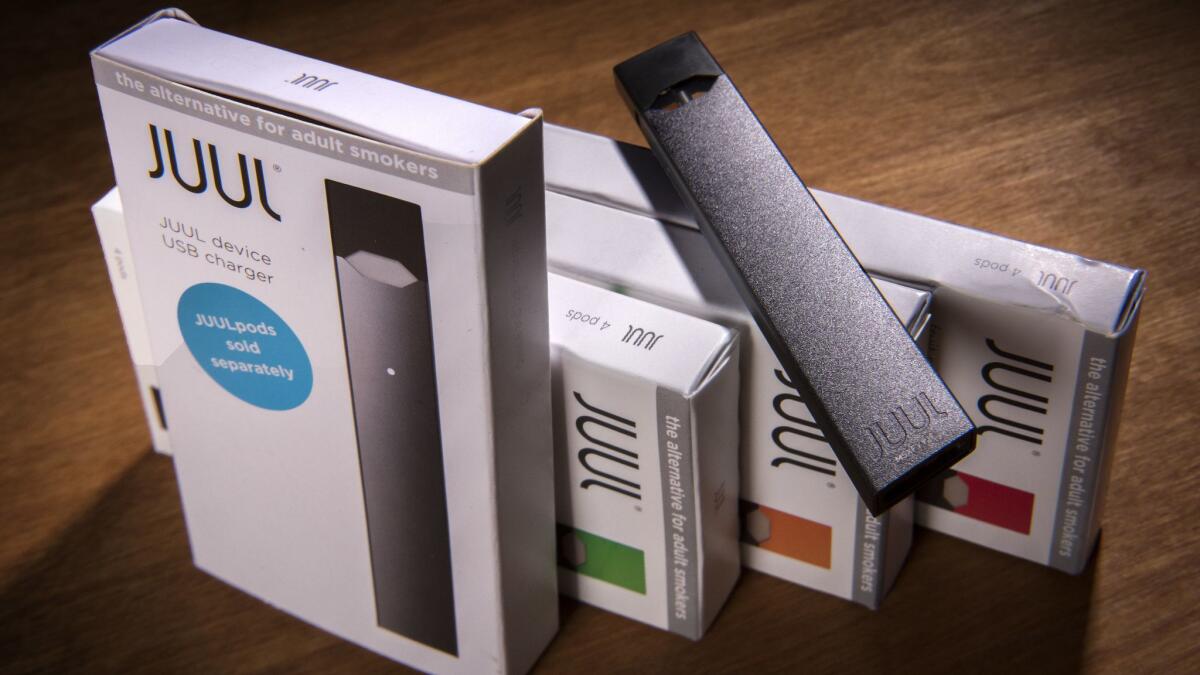
Monsees would use a TEDx talk in Brussels to explain their effort to “deconstruct” smoking, and early Juul advertisements used a catchy drum beat to assure consumers: “We threw away everything we knew about cigarettes.”
Juul records show the start-up collected research done by tobacco experts about nicotine — work on using salts to control harshness, written by a former top scientist at Reynolds, as well as methods to maximize nicotine delivery, and piles of literature on nicotine’s impact on adolescent brains.
“Certainly, the nicotine salt chemistry was one of the big breakthroughs,” Monsees said onstage at a 2018 tech start-up conference called Disrupt.
Three days before Christmas in 2015, the maker of Juul, Pax Labs, patented its own nicotine salt recipe — making reference to U.S. Patent 4,830,028A, the Reynolds salts from 1989.
On page 15 of the patent, Pax said it had “unexpectedly discovered” the “efficient transfer of nicotine to the lungs of an individual and a rapid rise of nicotine absorption in the [blood] plasma.” The company’s patent used graphics to show that its effects surpassed that of Pall Mall — a popular Reynolds cigarette — as users’ blood nicotine levels spiked dramatically, then fell by almost half within 15 minutes.
The compound would later become trademarked: JUULSALTS™.
“Addiction is central to the business model,” said David Kessler, a pediatrician who headed the FDA from 1990 to 1997, during the agency’s tobacco investigation. “With their nicotine salts, Juul has found the Holy Grail.”
In response, Juul did not directly address that accusation, but said its product offered a “public health and commercial opportunity of historic proportions” for the millions of adult smokers who die each year from cigarettes.
The patent also detailed the role of pH-neutralizing acids in the formula — including at least four of the chemical compounds that Perfetti had created in the Reynolds lab 37 years earlier.
And included in the cache of files that the FDA obtained from Juul was a copy of the confidential Reynolds nicotine salts investigation.
Monsees and Bowen did not respond to multiple requests for comment.
A Juul spokesperson said: “RJ Reynolds’ old work in the field of traditional burn cigarettes was widely known,” noting that Juul followed routine disclosure procedures, such as citing Reynolds’ patents and publications, as required by the U.S. Patent Office.
The spokesperson also said that research shows that nicotine is absorbed more slowly from Juul pods than from traditional cigarettes.
Before Juul, most vaping fluids contained 1% to 3% nicotine, the latter described as “super high” and intended for two-packs-a-day smokers, according to Jackler, the Stanford researcher. Juul offers pods that contain 5% nicotine, according to the company’s website.
Juul disputed Jackler’s characterization, saying that there were higher nicotine concentrations in other brands, and said assertions that Juul’s pods had two to three times the nicotine strength of a cigarette were “false.”
From 2016 to 2017, Juul’s sales skyrocketed by more than 640%. Its cartridges were so palatable that teenagers sometimes raced one another to finish inhaling them. Many said they didn’t know the pods contained nicotine. Each 5% cartridge contained the nicotine equivalent of about 20 cigarettes.
“Juul mimics the evil genius of the cigarette — but does it even better,” said Myers, the president of Tobacco-Free Kids. “They also pulled it off without any of the historical baggage, giving the deceptive illusion that it was safe.”
Anne Schuchat, the principal deputy director of the federal Centers for Disease Control and Prevention, told Congress during a hearing in September that doctors believe nicotine salts allow the addictive chemical to “cross the blood-brain barrier and lead to potentially more effect on the developing brain in adolescents.”
In a statement to The Times, Schuchat echoed her concern and said the salts “allow particularly high levels of nicotine to be inhaled more easily and with less irritation” than ingredients in previous e-cigarettes, and could enable nicotine dependence among youth.
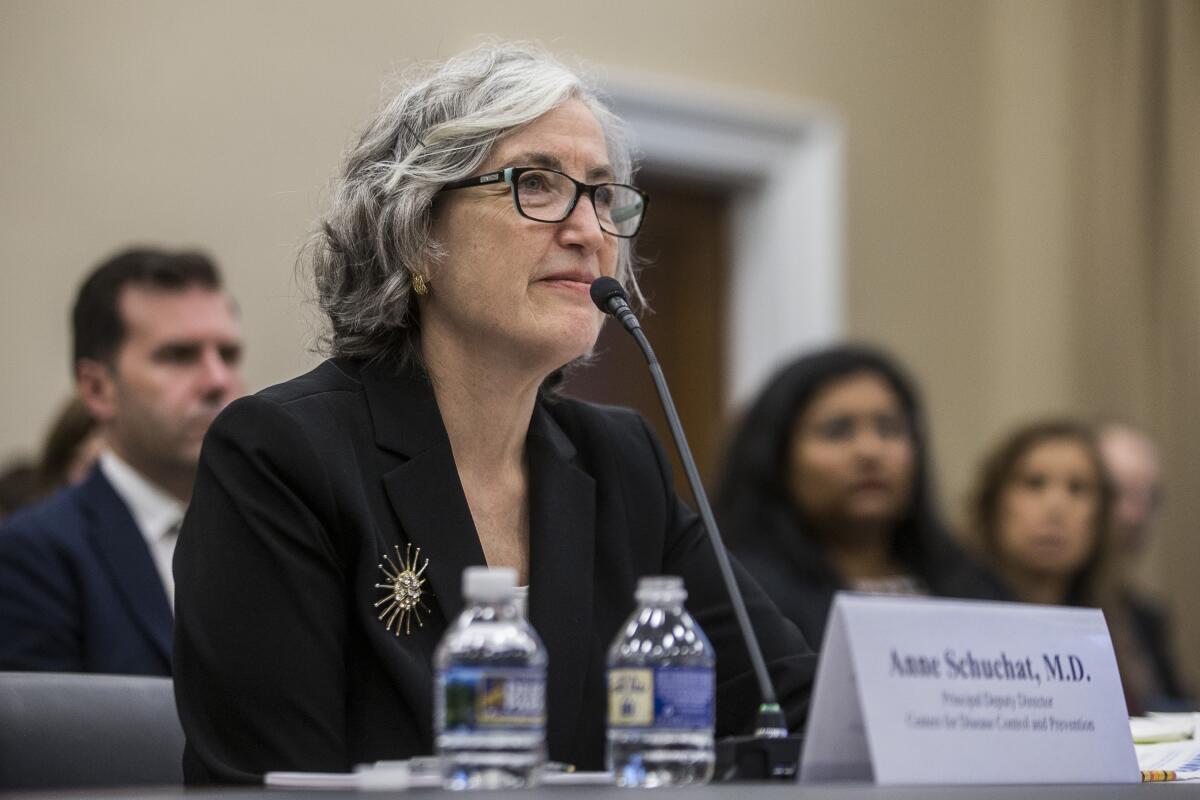
On April 24, 2018, the FDA ordered Juul to submit documents related to its product design and marketing practices following reports of rampant use among youths who may not have understood Juul’s debilitating effects on the brain.
Later that year, FDA agents arrived at Juul’s headquarters and seized additional records. The FDA has released less than 10% of the requested documents, including Perfetti’s laboratory records, to a researcher at UC San Francisco. The agency said it withheld the remaining files to protect trade secrets and other material. As such, the records provide only a glimpse into the chemical research that Juul kept on hand as the company designed its product.
Today, Juul comprises about two-thirds of the vaping market.
In 2018, the largest tobacco company in the U.S., Altria — the parent company of Philip Morris USA, which makes Marlboro cigarettes — purchased a 35% stake in Juul.
After the purchase, several of the tobacco company’s employees also started working at Juul: Altria’s former head of regulatory affairs, Joe Murillo, as well as senior scientists and sales managers.
In September, Altria’s former chief growth officer, K.C. Crosthwaite, became Juul’s CEO.
More to Read
Get the L.A. Times Politics newsletter
Deeply reported insights into legislation, politics and policy from Sacramento, Washington and beyond. In your inbox twice per week.
You may occasionally receive promotional content from the Los Angeles Times.

